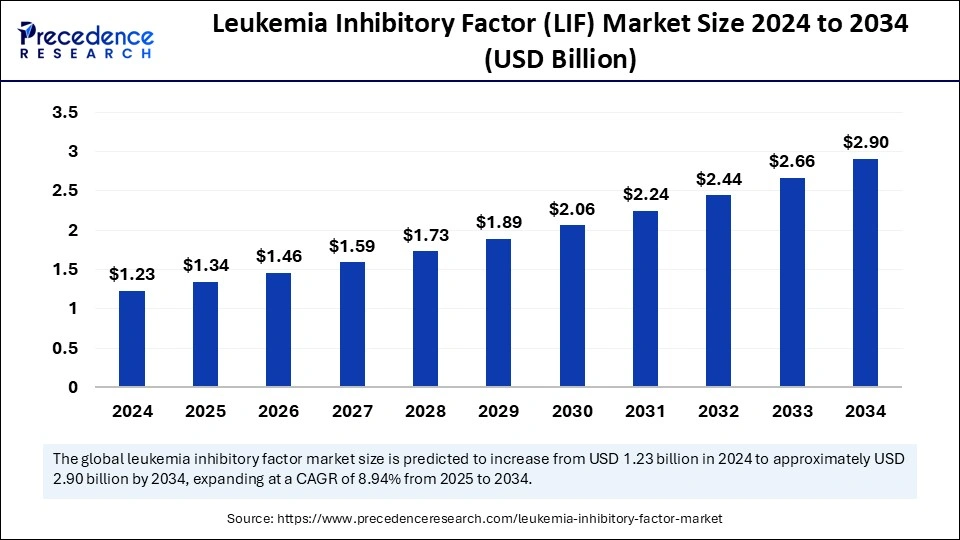Leukemia Inhibitory Factor (LIF) market to expand at an 8.94% CAGR, reaching USD 2.90 billion by 2034 from USD 1.23 billion in 2024.

Leukemia Inhibitory Factor (LIF) Market Key Takeaways
-
North America led the leukemia inhibitory factor (LIF) market with a 41% share in 2024.
-
Asia Pacific is projected to experience rapid growth throughout the forecast period.
-
Europe is expanding at a notable CAGR, showing strong market potential.
-
The recombinant LIF segment dominated the market in 2024.
-
The LIF antibodies segment is expected to witness significant growth in the coming years.
-
The cancer treatment segment held the highest market share in 2024.
-
The stem cell research segment is projected to grow at the fastest rate over the forecast period.
-
Hospitals accounted for the largest market share in 2024.
-
Research institutes are anticipated to expand rapidly in the coming years.
Leukemia Inhibitory Factor (LIF) Market Overview
The Leukemia Inhibitory Factor (LIF) Market is expanding rapidly due to its critical role in cell proliferation, immune modulation, and cancer research. LIF has been extensively studied for its involvement in tumor progression and its potential as a target for cancer immunotherapy. In addition to oncology, its application in stem cell research, neurobiology, and reproductive health is driving demand.
The biotechnology and pharmaceutical industries are increasingly utilizing LIF in cell culture media, as it plays a fundamental role in maintaining stem cell viability. Growing research into LIF’s dual role in cancer—both promoting and inhibiting tumor growth—has sparked interest in its therapeutic potential, further boosting market growth.
Leukemia Inhibitory Factor (LIF) Market Drivers
The rising incidence of cancer worldwide is a major driver of the LIF market, as researchers explore its role in tumor progression and immune evasion. Increasing investments in oncology drug discovery and regenerative medicine are further propelling demand. The expanding use of LIF in embryonic stem cell research and biopharmaceutical manufacturing is another critical growth factor.
Additionally, advancements in genetic engineering and molecular biology have enabled a deeper understanding of LIF’s signaling pathways, increasing its relevance in targeted therapies. The biotechnology industry’s focus on developing high-quality cell culture media has also contributed to market expansion.
Leukemia Inhibitory Factor (LIF) Market Opportunities
The market holds significant opportunities in cancer immunotherapy, where LIF-targeted treatments could revolutionize oncology care. Researchers are investigating its potential as a biomarker for cancer progression, opening new avenues for precision medicine. The increasing demand for recombinant LIF in cell culture media presents a lucrative opportunity for biopharmaceutical companies.
Additionally, the development of LIF inhibitors for cancer treatment offers a promising new drug class for pharmaceutical firms. The rising adoption of organoid technology in disease modeling and drug discovery further enhances LIF’s commercial potential.
Leukemia Inhibitory Factor (LIF) Market Challenges
The complexity of LIF’s role in disease progression poses a challenge for drug development, as it can function as both a tumor promoter and suppressor depending on the context. Regulatory barriers for biopharmaceutical applications add to commercialization hurdles, requiring extensive clinical validation.
The ethical concerns surrounding stem cell research may also impact public perception and market expansion. Additionally, the high costs associated with recombinant LIF production can limit its accessibility for smaller research institutions and emerging markets.
Leukemia Inhibitory Factor (LIF) Market Regional Insights
North America dominates the market due to strong research funding, advanced biotechnology infrastructure, and increasing demand for cancer therapies. Europe follows closely, with leading universities and pharmaceutical companies driving innovation in LIF applications.
The Asia-Pacific region is emerging as a key player, particularly in China and Japan, where investments in stem cell therapy and cancer research are growing. Latin America and the Middle East & Africa have developing markets, but limited research capabilities and regulatory complexities may hinder growth.
Leukemia Inhibitory Factor (LIF) Market Recent Developments
Recent advancements include the development of LIF inhibitors as potential cancer therapeutics and increased research into its role in regenerative medicine. Biotechnology companies are investing in recombinant LIF production for cell culture applications.
Academic collaborations have led to promising discoveries regarding LIF’s role in tissue repair and immune regulation. The regulatory landscape is evolving, with agencies reviewing new LIF-based therapies for clinical use.
- In October 2024, Novartis announced the approval from the U.S. Food and Drug Administration (FDA) for the Scemblix® (asciminib) for adult patients who are newly diagnosed with Philadelphia chromosome-positive chronic myeloid leukemia in chronic phase (Ph+ CML-CP).
- In February 2024, Johnson & Johnson in collaboration with Pharmacyclics LLC announced the approval from the U.S. Food and Drug Administration (FDA) for expanding IMBRUVICA® (ibrutinib) with an oral suspension formulation for adult patients going through the treatment of chronic lymphocytic leukemia (CLL), and other related diseased conditions after failure of one or more lines of systemic therapy.
Leukemia Inhibitory Factor (LIF) Market Companies
- Bristol Myers Squibb
- InVitria
- Johnson & Johnson Private Limited
- Gilead Sciences Inc.
- Sanofi S.A.
- Novartis AG
- Roche
- Amgen Inc.
- Merck KGaA
Segments Covered in the Report
By Product Type
- Recombinant LIF
- LIF Antibodies
- LIF Receptor Agonists/Antagonists
By Application
- Cancer Treatment
- Stem Cell Research
- Neurological Disorders
- Fertility Treatment
- Others
By End-User
- Hospitals
- Research Institutes
- Biotechnology Companies
- Others
By Geography
- North America
- Europe
- Asia-Pacific
- Latin America
- Middle East & Africa
Ready for more? Dive into the full experience on our website!
